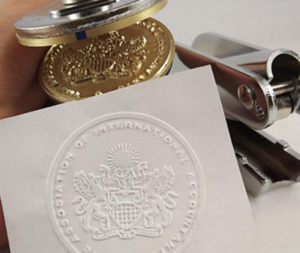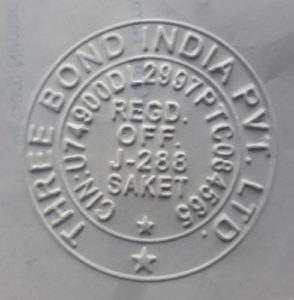“The Common Seal of a CHS is not So Common and the Official Seal is not so special either” – This is what I can put based on my studies of 100s of resources and enquiries from experts across the verticals. Newly formed Co-Operative Housing Societies are often not aware of the types of stamp they would use for different purposes. Result is that, there are a plethora of litigations pending before the different forums and courts arising out of misuse, forgery or wrong use of the stamps/seals. As a widely known fact and established through various rulings of courts across globe, the aim behind using a stamp/seal is unambiguous demonstration of identity of an organization on whose behalf the stamp is affixed. Each organization on the planet can have its own stamp exhibiting its unique identity capable of clearly distinguishing it from the others especially, the confusingly similars.
Paradigm of Unique Identity and Status of a CHS
As far as UNIQUE identity of an organization is concerned, the registrations under the relevant laws provide the organization its uniqueness in terms of some numbers, may be alphanumeric and certain pictorials otherwise called logo. Name alone cannot provide uniqueness to an entity but when the Name, Numbers and pictorial representations are cited together the entity gets unique. The concept is pretty straightforward, based on logic and precisely relates to a mathematical concept of permutation-combination. Because of this very reason, legally valid stamps for companies & organization all use more than one attribute to stay unique and assume relevance. There are a host of court rulings all across globe which have rendered incomplete identities as inadmissible evidence before court of law.
Of course a self-governed entity, all Co-operative Housing Societies by virtue of their governing Act fall within the ambit of Co-operative Society Act 1912, as amended time to time. The said Act empowers a CHS as a body corporate with a common seal under Section 18 of the Act.
It is a trite law that the moment any legal entity assumes a specific status, it becomes incumbent upon the entity to adhere to the highest of standards matching to the status accorded. For example, if CHS has been kept out of direct purview of RTI, the highest level of transparency too is obligated upon CHS by the supreme law of land, the constitution of India. The Crux is that corporate standards and SOPs thereof would apply to a CHS as an obligation that among many things includes, acknowledging the share of members through a duly stamped Share Certificates and due acknowledgment of their concerns. (Indian Stamp Act to some measure would also attract)
So What is a Common Seal for a Body Corporate?
Common seal, corporate seal or company seal are all one and the same thing with wide acceptable terminology across the globe. Instruments (agreements/contracts/shares) executed by the companies internationally use these terms interchangeably.
In the Indian context, there is no set definition for Common Seal under the Companies Act, 2013. It is an international concept adopted in India and ICSI has laid down certain standards for it effective Nov. 6th 2008. As per the Secretarial Standards set forth by Institute of Company Secretaries of India, a Common Seal means: “the metallic seal of a company which can be affixed only with the approval of the Board of Directors of the Company. It is the signature of the company to any document on which it is affixed and binds the company for all obligations undertaken in the document. In other words, Common Seal is the official signature of the company.”
The metallic disc with blind embossing capability is gold standard for a Common Seal and it is practiced all over the world, let alone India. Common seal does not use ink and there are only limited places where they can be used viz. share certificates, agreements and conveyance deeds. Before they are used a register has to be maintained for entries making mention of the document over where the common seal was used and mention of the authorized person who signed the Instruement/document when the Common seal was affixed. Common seal is company’s individual signature and identity despite the fact that it doesn’t have a physical presence.
The standard laid by ICSI requires that each company shall have only one common seal, since the day of its incorporation. Territory wise though, there could be many official seals of the company but all essentially have to be a FACSIMILE of the Common Seal having mention of territory or branch.
Manner of use of Common seal will be guided by provisions in the Article of association but must be within the norms of Company Act. While, the manner of use of an official seal should be guided by the MoM or board resolution passed for that matter at any time post incorporation. Introduction of each new official seal will require board’s resolution and Minute of Meeting to make a mention of.
Common Seal in case of Co-operative Housing Society
So, how should a Co-Operative Housing Society have and use stamps in undertaking its affairs. Although, having governed by a set of its own byelaws, a CHS essentially falls under Co-operative Society Act 1912. Section 18 of said Act provides for a common seal by virtue of registration under the Act which makes the CHS a body corporate. Section 18 of society’s Act reads as “Societies to be bodies corporate.—The registration of a society shall render it a body corporate by the name under which it is registered, with perpetual succession and a common seal, and with power to hold property, to enter into contracts, to institute and defend suits and other legal proceedings and to do all things necessary for the purposes of its constitution.”
When a Co-Operative Housing Society too becomes a “body-corporate” after getting registered, transacting any business by or on behalf of CHS will be undertaken in terms of widely accepted standard practices for all bodies-corporate under law. Implications are that almost everything including manner of using a seal/stamp applies to a CHS similar to the entities in India registered under Company ACT. Real implications are yet broader as the Act doesn’t simply use a word “company” for the co-operative Soc. it instead uses “body-Corporate” signifying a worldwide concept.
Now coming to the point of meaning & scope of the Body corporate, it broadly means a corporate entity which has a legal existence. The term “body corporate” is defined in Section 2(11) of the Companies Act, 2013. This includes a private company, public company, one personal company, small company, Limited Liability Partnerships, foreign company etc. A “body corporate” or “corporation” also includes a company incorporated outside India.
A legal allegory from mandate of law is that, in the matter of using seal/stamps a CHS will adopt only standard practices under Corporate Act & laws and will not indulge into a practice forced upon by the whims of its office bearers.
Official Seal of CHS only a Carbon Copy of Common Seal
The company’s and corporations can have branches and offices all across the globe as part of their expansionist nature and profit making objectives, but a CHS does not have branches, because of its very geo-specific nature and benevolent objective instead of expansionist. So, When a company under provisions of Company ACT read with secretarial standards can have multiple official seals as part of their branch specific requirement, should a CHS too have an official seal for day to day affairs, one of which includes issuing demands/notices and acknowledging receipts of communications/ complaints? Surely it can have under a resolution and MoM to that effect.
One thing that is pretty much clear that a Common seal is not to be used for sending notices or issuing circulars etc. as the purpose of a common seal (identity of a CHS used in share certificate/ agreements/ conveyance/) is undermined and would go against the widely accepted practice in body-corporate world. So, the CHS instead shall use an official seal for its day to day affairs that would cover two way traffic of communications. Meaning, under what official seal/stamp the information are disseminated from Society’s office, the same seal shall be used for acknowledging the receipts of communications from members.
The official seal so required for everyday affairs has to be a FACSIMILE of the Common seal by virtue of a CHS also being a body-corporate. It is however seen that standard practice is not adopted in the matter of affixing the stamps in few CHSes and the Managing Committee is least bothered about it. The communication from Society office to the members comes under one kind of stamp while the receipt of member’s communication by society’s office is acknowledged under a different stamp. Worse, the stamps acknowledging the receipt are plain rubber stamps that do not bear even the Soc. Reg. No. let alone logo. Even worse, when a well informed member enquires about this anomaly in affixing the stamps, management committee either eludes clarity or gives weird explanation. One such explanation given is that the manager is not authorized to affix a stamp bearing reg. no. because such stamp constitutes a Common Seal and that Common Seal remains in the Custody of Secretary which can only be used by the Secretary or Chairman in his absence.
How do Common Seal and Regular Official Seal look Like?
Most widely used and falling in under the standards set by ICSI following are the typical images to give you a sense of how the Common seal and Official Seals look like. Images are self explanatory of their purposes and underlying idea if you look at the images carefully.
Relevance of the Common seal under The Companies (Amendment) Act, 2015
Under the Companies (Amendment) Act, 2015, the option for use of common seal has been left up to the companies itself. So, how the authentication of the documents are to be done in absence of a common seal. Pretty simple, if a body-corporate doesn’t want to use Common Seal the Digital signature will be required as per section 5 of Information Technology Act 2000 for proper authentication (Any organization or individual can apply for and get a Digital Signature Certificate). But, then Digital signature find utility only in online modes i.e in the cases where issue or transmission of the documents are Online for example in filing ITR or claiming ownership of any web-property, a domain name just for instance.
So, how will the authentication be done under amended act in case where issuance / authentication of the documents to be done the body-corporate doesn’t have a Common seal? It is apt to go through Section 7 of The Companies (Amendment) Act, 2015, which reads as ” In section 46 of the principal Act, in sub-section (1), for the words “issued under the common seal of the company”, the words “issued under the common seal, if any, of the company or signed by two directors or by a director and the Company Secretary, wherever the company has appointed a Company Secretary” shall be substituted.” What it means is that where the company doesn’t have a common seal, authentication will be done by signature of two directors or one director and a secretary as the case may be.
Now, this projects two scenario online & offline. If done online, it will require DSC of three, the company itself and two persons so named. But, if the company is having a Common seal, offline authentication is best way to go with, which would involve affixing Common Seal (Essentially, the signature of Company) and the signatures of two authorized persons so named.
In the first instance, it may look confusing in as much as the significance of the Common Seal (signature of Company) has been reduced, but it is not. The Common seals will be pretty much necessitated till any document on behalf of company is executed offline. In other words, Authentication Process has not been compromised, only options are given, either by DSC or a Common Seal. So, it is improper to say that Common Seal has been done away with, under the Companies (Amendment) Act, 2015.
Important Takeaway on Common Seal & Official Seal of a Housing Society
1.Common Seal if adopted by virtue of provisions under Incorporation, has to be used only in specific places: Share Certificate, Agreements entered into by the Housing Society or Conveyance Deeds.
2.Common Seal is the signature of ‘Society as legal entity’ and Should be a Metallic disc with blind embossing features as practiced worldwide since long and also laid under Secretarial standards by ICSI (The idea behind is lesser chances of forgery). Just any rubber seal cannot be made a common seal.
3.Secretarial Standards for bodies-corporate under Companies Act 1956 was re-commendatory. But, after Companies Act 2013, the Secretarial standards are mandatory. A CHS cannot deviate much from these standards for its also being a body-corporate.
4.Official Seals should be FACSIMILE of Common Seal and the office bearers are obligated to empower a person attending Society office to acknowledge communications under proper Official Seal. Yes, if any of the committee members duly elected, himself sits in society office, signature by the member on receipts will make the communication a legally admissible piece of evidence in the court.
5. Unique Identity of a CHS is not on account of one single attribute alone viz. Name, Reg. No. & Logo ( adopted through due procedure). Meaning they are not exclusive to each other rather complementary to each other. Upon their co-existence only true Identity of Society, a body corporate is established. Weightage wise Name < Logo < Registration No. is the acceptable precedence for evident reasons. Because of this, Parking Stickers in Societies flaunt Logo on them. But, then that is also not a correct practice, name & Reg No. too, should reflect though, in fine Print over the stickers.
6. An SOP must be in place for proper acknowledgements of communications, proper record keeping and a defined response time for communications addressed to Management Committee.
This was it, see you on the other side! Keep coming back and forget not to speak your mind please. You comments helps the author writing more.




